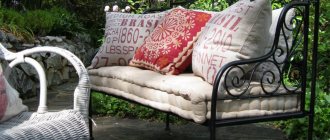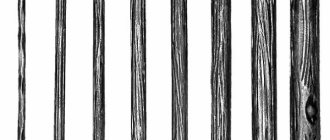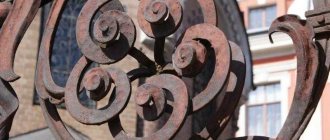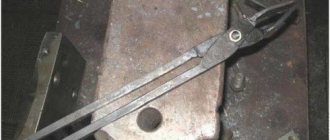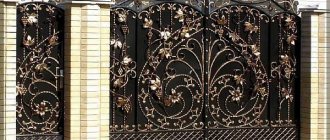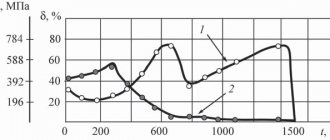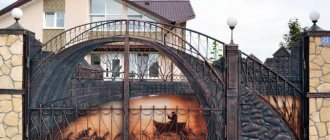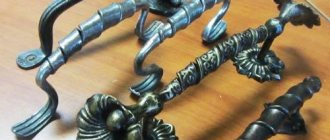Decor and accessories
Artistic forging has not lost its relevance for the exterior: the use of this method of making forged gates, fences, decorations for personal plots and landscape design is a classic.
But forging returned to the interior just a couple of years ago, when designers again paid attention to it and gave it a more modern and minimalistic look. The main use of artistic forging today is accessories. Various decorative items are made from metal: from mirror frames to lamps. Let's take a closer look at forged products.
- Mirrors. Forged elements on frames are the same standard technique for framing mirrors as wood. Due to their strength, mirrors of different thicknesses and sizes are placed in metal frames. Models are wall-mounted, floor-mounted, with shelves or hooks. Form - no restrictions. The flexibility of the metal allows you to bend not only a standard circle or rectangle, but also an oval, wave, drop, etc. Forging looks especially luxurious in the interior in combination with the arched shape of the mirror.
- Watch. If earlier the mechanism was richly decorated with forged elements such as leaves, clusters, flowers, then modern design assumes straight lines and a minimum of details. The most popular model: round with Roman numerals.
Look at examples of using clocks in the interior.
- Decorative panels. Wall decoration does not have to be functional - artistic forging in the form of a certain plot looks much more original in the interior than a painting or photo in a frame.
The photo shows a forged panel
- Lamps. Forged products in the interior often play the role of lighting fixtures: chandeliers, sconces, lanterns, even floor lamps and table lamps are popular. Before purchasing, the main thing is to make sure that the metal will fit into the design of the room.
- Flower stands. The classic use of forging in the interior is an openwork flower stand for 1 or several plants. The metal construction is both durable and visually lightweight, making it a dream for most gardeners.
- Fireplace and stove grates. In private homes, one cannot do without such an interior item as a fireplace screen. It combines a decorative function with a protective one, preventing burning logs from falling out of the stove.
- Stair railings, fences, partitions. Artistic forging is often used when it is necessary to fence a staircase or an open area on an elevated surface. Forged products in this case look lighter, do not weigh down the space, and do not block the view.
In addition to the listed methods of application, statues or figurines, handles for entrance and interior doors, curtain rods, candlesticks and much more are also made from this material.
History of the use of forging in the interior
Craftsmen began forging different types of products for decorating rooms and facades back in the Middle Ages. But at this time, special importance was not attached to the originality of designs. For example, they were characteristic of the Romanesque style in the design of architectural buildings. True, they were used to a greater extent due to reliability and durability. From the 17th century, balcony railings and staircase railings began to become thinner and complemented with various decorations. They were often decorated with thin silhouettes of vases and grapevines. This trend came from the Greeks. Later, each type of furniture, decorations is improved according to popular trends. They were used mainly for decorating homes and residences of famous people. For example, many Romanov palaces are framed by unique lattice fences with various patterns. Such designs have survived to this day and are used as examples to follow.
Wrought iron furniture
Forging in the interior of an apartment is represented not only by accessories, but also by familiar furniture.
Forged furniture is often found in the bedroom: the metal headboard of a forged bed, decorated with carved elements, looks elegant and noble.
Standard forged products in the kitchen - tables, chairs. Moreover, this can be as a set in the same style and color. So is the diversity - artistic forging goes well with each other.
In some cases, one table on an openwork leg is enough; wooden chairs are selected for it - according to the color of the metal or tabletop.
The photo shows a set of metal furniture
A wrought iron coffee table near the sofa will become the accent of the living room. It’s good on its own, but can be added in the form of a rack, shelf, or console in another part of the room.
Often, forged furniture is ordered for the hallway: the very option when the product is purchased once and for a long time (if not forever). Standard hallway contents: a hanger (floor or wall), a shoe rack with a soft leather seat, a console for keys, letters and other small items.
The photo shows a shelf with hooks for the hallway
Various hanging shelves and small shelving will be appropriate in all rooms - from the hallway to the nursery.
Romanesque
The Romanesque (from the Latin romanus - Roman) style, which is essentially medieval, is characterized by solidity and massiveness. “My home is my fortress” is specifically about Romanesque buildings. So the forged products also bore the stamp of a “defensive” mission: the gates and grilles were massive, made up of square rods placed at an angle or vertically. The gaps between the rods were filled with symmetrical spirals, and the entire surface of the lattice was neatly filled with such decorations.
The characteristic pattern consists of curls: they grow from one thick root, intercepted by a collar; the development and connection of curls is strictly symmetrical and periodic; large curls are either densely spaced or have a flower made of small curls in the center.
Character traits
- monumentality
- semicircular arches
- typical element - volute
- the pattern is dense, symmetrical, repeating
Examples of combinations with other materials
Forged products for interior use in residential premises are rarely solid metal: for greater functionality and comfort, forging is diluted with other materials.
Tree
Cold forging in combination with warm wood becomes more comfortable and neutral. The seats of stools or chairs, table tops, and shelves can be made of wood.
The photo shows a combination of wood and metal
Glass
The glass + iron duet looks cold on one side, and light and airy on the other. A glass tabletop, for example, unlike a wooden one, allows the table to remain visually light and weightless.
Stone
Making products from metal and stone is a tribute to tradition. Tables or shelves look solid, sometimes even monumental. Fits into luxurious palace interiors.
Leather
Furniture with seats (chair, sofa, couch) is harmoniously complemented by details made of natural or artificial leather or suede. Almost all other furniture fabrics look ridiculous when paired with iron.
Forged mirror in the interior
Beautiful mirrors in a neat metal frame look sophisticated and elegant. The most popular are models with massive decoration. These mirrors can be hung on the wall or simply installed indoors. Wall-mounted models can be equipped with a small glass or wooden shelf. It is attached to the supports protruding under the mirror. Models equipped with a frame-stand look fabulous. They can even be located in rooms where children and teenagers live. Thanks to the durable, stable frame, the position of the mirror can be adjusted. The angle of inclination makes it much more convenient to try on clothes. In addition, many models are decorated with metal leaves and flowers, stripes, and nets. Their protruding parts can be used to hang decorations.
In what style can it be used?
When planning to add a forged table or clock to your home, you should understand: forging is quite a striking element, so in some areas of design it is simply inappropriate. Accordingly, walls, windows, floors and other surfaces must match the style.
- Classical. Strict lines, a minimum of decoration, high quality - these are the properties that forged classic elements should have.
- Baroque, Empire. Both directions are characterized by excessive elegance: there should be a lot of decor. Curls, leaves, spirals, flowers, and other natural patterns are welcome.
The photo shows a forged pattern in a classic style
- Loft. The forging is minimalistic, the products are a little rough and brutal.
- Minimalism. If you give the metal the same simple, laconic shape as the surrounding interior, there is a high chance of achieving a harmonious picture.
- Provence. Here the iron is not dark, but white. Definitely twisted, sophisticated, “airy”.
- High tech. Instead of a round cross-section, it is better to choose a square one, based on geometry and clarity of lines.
Artistic forging can be different: rough, soft, simple or abstract. Look for the style that suits you!
Where to order products of various styles
If you need to order artistic forging products of one style or another, or perhaps something exclusive that does not fit into a certain style, we recommend looking for blacksmiths in the region you need using our forge catalog.
Sections: Forged products
Previous article: Wrought iron fences, railings, railings, fencing, hedges - what's the difference Next article: Wrought iron railings for balconies or railings? Is there a difference?
